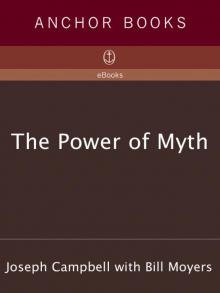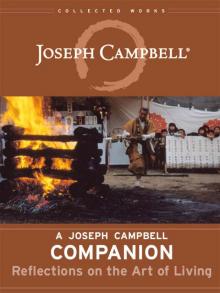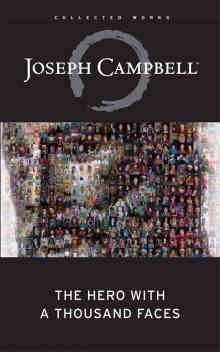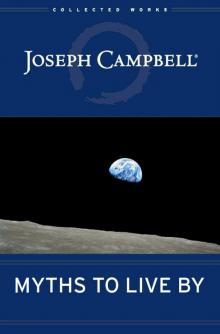- Home
- Joseph Campbell
The Hero with a Thousand Faces
The Hero with a Thousand Faces Read online
Joseph Campbell
The Hero with a Thousand Faces
Copyright Notice
The Hero with a Thousand Faces
Joseph Campbell Foundation (JCF.org)
United States of America
Electronic edition (with revisions and additions) copyright © 2020 by Joseph Campbell Foundation
Third edition (with revisions) copyright © 2008 by the Joseph Campbell Foundation
Second edition (with revisions) copyright © 1968 by Princeton University Press
Original edition copyright © 1949 by Bollingen Foundation and published by Pantheon Books
All rights reserved.
No part of this work may be reproduced or transmitted in any form or by any means, electronic or mechanical, including photocopying, recording, or by any information storage and retrieval system, without permission in writing from the Joseph Campbell Foundation.
Contact JCF to inquire about permission at the address [email protected]
For information about this edition, see the Editor's Note.
For sources used, see the Bibliography section.
For sources of images use and other acknowledgments, see the Illustrations list.
Ebook by
tillpoint Digital Press
version 1.1.0 PublishDrive
Thank you for maintaining this ebook for your personal use.
If you have received this book gratis, please join JCF's associates in supporting our on-going efforts to bring out new, inspiring editions such as this by making a donation at JCF.org.
The Joseph Campbell Foundation is a registered 501(c) 3 United States not-for-profit corporation.
For further information, visit our website (www.jcf.org)
Hardcover Third Edition published by
New World Library
Print ISBN 978-1-57731-593-3
Audiobook ISBN 978-1-51136-026-5
Ebook ISBN 978-1-61178-033-8
The Collected Works of Joseph Campbell
At his death in 1987, Joseph Campbell left a significant body of published work that explored his lifelong passion, the complex of universal myths and symbols that he called “Mankind’s one great story.” He also left, however, a large volume of unreleased work: uncollected articles, notes, letters, and diaries, as well as audio- and videotape-recorded lectures.
Joseph Campbell Foundation (JCF) — founded in 1990 to preserve, protect, and perpetuate Campbell’s work — has undertaken to create a digital archive of his papers and recordings and to publish The Collected Works of Joseph Campbell.
Robert Walter, Executive Editor
David Kudler, Managing Editor
THE COLLECTED WORKS OF JOSEPH CAMPBELL
Print:
Ebooks:
Video:
Audio:
TO MY FATHER AND MOTHER
Table of Contents
About the Collected Works of Joseph Campbell
Editor's Foreword to the 2020 Collected Works Edition Notes on the Text
PREFACE TO THE 1949 EDITION
PROLOGUE - The Monomyth 1. Myth and Dream
2. Tragedy and Comedy
3. The Hero and the God
4. The World Navel
PART I - The Adventure of the Hero CHAPTER I - Departure 1. The Call to Adventure
2. Refusal of the Call
3. Supernatural Aid
4. The Crossing of the First Threshold
5. The Belly of the Whale
CHAPTER II - Initiation 1. The Road of Trials
2. The Meeting with the Goddess
3. Woman as the Temptress
4. Atonement with the Father
5. Apotheosis
6. The Ultimate Boon
CHAPTER III - Return 1. Refusal of the Return
2. The Magic Flight
3. Rescue from Without
4. The Crossing of the Return Threshold
5. Master of the Two Worlds
6. Freedom to Live
CHAPTER IV - The Keys
PART II - The Cosmogonic Cycle CHAPTER I - Emanations 1. From Psychology to Metaphysics
2. The Universal Round
3. Out of the Void — Space
4. Within Space — Life
5. The Breaking of the One into the Manifold
6. Folk Stories of Creation
CHAPTER II - The Virgin Birth 1. Mother Universe
2. Matrix of Destiny
3. Womb of Redemption
4. Folk Stories of Virgin Motherhood
CHAPTER III - Transformations of the Hero 1. The Primordial Hero and the Human
2. Childhood of the Human Hero
3. The Hero as Warrior
4. The Hero as Lover
5. The Hero as Emperor and as Tyrant
6. The Hero as World Redeemer
7. The Hero as Saint
8. Departure of the Hero
CHAPTER IV - Dissolutions 1. End of the Microcosm
2. End of the Macrocosm
EPILOGUE - Myth and Society 1. The Shapeshifter
2. The Function of Myth, Cult, and Meditation
3. The Hero Today
Annotated Bibliography
About Joseph Campbell
About the Joseph Campbell Foundation
Acknowledgements
Illustrations List
Editor's Foreword
to the 2020 Collected Works Edition
Joseph Campbell (1904–1987) was a pre-eminent American scholar of literature and comparative mythology.
Two things about his study of myth are worth noting. First, where many of his colleagues focused on the specifics of a particular culture’s myths, exploring what made that society’s foundational stories unique, Campbell was fascinated with the ways in which all myths told what he called “the one great story of mankind.”
The other interesting thing about Campbell’s approach to mythology was that he was very focused on the humanist part of the religious equation, rather than the theological. While he studied, wrote, and lectured on humanity’s metaphysical traditions for over sixty years, Campbell’s focus was not on the question “What is out there?” but rather on the question, “Why do we tell the stories that we do about whatever it is that is out there?”
As a young man, he studied for a doctorate in medieval literature at New York’s prestigious Columbia University. His studies focused on the tales of England’s King Arthur and his Knights of the Round Table, which were largely written in Old French and Old German, and so he applied to study at the University of Paris-Sorbonne in France, where he arrived in 1927.
Paris at that time was a center of Modernist culture and new ideas. While studying there (as well as at the University of Munich in Germany), Campbell was exposed not only to the great, groundbreaking novels of James Joyce and Thomas Mann and the radical art of Pablo Picasso, Antoine Bourdelle, and Paul Klee, all of whom integrated mythic motifs into their very modern work, but also to the revolutionary psychological teachings of Sigmund Freud and Carl Gustav Jung. These last two brought young Joseph Campbell to the epiphany that, as he would later put it, “Myths are public dreams; dreams are private myths.”[1] Campbell was also exposed to the great mythic traditions of India and East Asia. To him, it seemed clear: everything that he was studying, from contemporary artists (“the modern mythmakers”[2]), to modern scientists, to ancient texts, to the legends of Arthur and his knights all seemed to be speaking in the same language — the language of myth. Campbell was so excited by what he was learning that he went back to New York in October, 1929 to tell his doctoral advisers about what he had learned:
I came back to the United States about two weekends before the Wall Street Crash. And th
ere wasn’t a job in the world. I went back up to Columbia to go on with my work on the Ph.D. and told them, “This whole thing has opened out.”
“Oh, no,” they said. “You don’t follow that. You stay where you were before you went to Europe.”
Well, I just said, “To hell with it.”[3]
He quit the doctoral program.
The global economic disaster that is called in the United States the Great Depression continued through the 1930s, and like many other people, Campbell was unemployed for five years. And so he read. All of the things that the doctoral committee had wanted him to forget about, he now studied at his leisure: modern literature, history, philosophy, Asian religion, psychology, Celtic legends, Native American legends, African legends — anything he could find.
In 1934, he got a job teaching at Sarah Lawrence College, a new liberal arts college for women. He would teach there until his retirement in 1972.
He was hired as a literature professor, but his classes were all informed by his mythological studies. Soon, his Introduction to Mythology class became one of the most popular at the college.
A decade later, a major New York publisher approached Campbell and asked him to write a collection of myths — “a modern Bullfinch.”[4]
I said, “I wouldn’t touch it with a ten-foot pole.”
They said, “What would you like to do?”
I said, “I’d like to write a book on how to read a myth.”[5]
He would work on that book over the next five years, incorporating everything that he had learned, both from the various mythological traditions around the world and from modern psychology. As he worked, he began to focus on the single hero story that seemed to be repeating itself everywhere — in the oldest Sumerian epics, in folktales from the Pacific Islands and the Siberian forests and the African savannah, in the lives of great religious heroes like Gautama Śakyamūni and Jesus, in the case notes of psychiatric patients, and in the modern novels of authors like Joyce and Mann. Campbell described that universal story as follows:
A hero ventures forth from the world of common day into a region of supernatural wonder: fabulous forces are there encountered and a decisive victory is won: the hero comes back from this mysterious adventure with the power to bestow boons on his fellow man.[6]
Because the hero that he was describing was every hero, and, looked at psychologically, was every individual, Campbell chose to title his work The Hero with a Thousand Faces.
This book has been in print continuously since its publication in 1949. It has been published into more than twenty languages and has sold well over a million copies, making it one of the most popular academic books ever published.
Part of its popularity is that, while it is scholarly in its exploration of its subject, The Hero with a Thousand Faces is universal in its appeal. It is looking at the basis for stories, a subject that fascinates many people.
Part of its popularity, too, has been that it has been used by creative artists of many kinds — novelists, film-makers, composers, songwriters, painters, video game designers, rollercoaster designers and many more — as a blueprint to leading an audience through a profound, transformative experience. As Campbell said, artists are the modern mythmakers, and since the publication of this book, they have used Campbell’s masterpiece to learn not only how to read a myth, but how to create one.
The most famous use of The Hero with a Thousand Faces as a road map was by American film director George Lucas when he created the Star Wars films:
I wrote many drafts of this work and then I stumbled across The Hero with a Thousand Faces. It was the first time that I really began to focus. Once I read that book I said to myself, “This is what I’ve been doing. This is it.” […] The Hero with a Thousand Faces was the first time a book began to focus what I had already been doing intuitively.[7]
And so, as you read this book, consider: Joseph Campbell explores in these pages ancient myths from around the globe, and yet his point is that the myths live everywhere there is a human imagination to give them life. As he puts it,
The latest incarnation of Oedipus, the continued romance of Beauty and the Beast, stands this afternoon on the corner of Forty-second Street and Fifth Avenue,[8] waiting for the traffic light to change.[9]
David Kudler
Managing Editor
The Collected Works of Joseph Campbell
Mill Valley, California
September 28, 2020
* * *
ENDNOTES
[1] Joseph Campbell, Myths to Live By (San Anselmo, California: Joseph Campbell Foundation, 2010), "The Impact of Science on Myth ."
[2] The Hero’s Journey: Joseph Campbell on His Life and Work, (San Anselmo, California: Joseph Campbell Foundation, 2018), "The Return Threshold."
[3] Joseph Campbell, The Hero’s Journey, "The Vision Quest."
[4] Bullfinch’s Mythology is a well-known English collection of Greek, Roman, and medieval European legends, published by Thomas Bulfinch in London, England, 1867.
[5] Joseph Campbell, The Hero’s Journey, "The Boon."
[6] Joseph Campbell, The Hero with a Thousand Faces (New York: Joseph Campbell Foundation, 2020), "Prologue."
[7] George Lucas, quoted in Joseph Campbell, The Hero’s Journey, "The Return Threshold."
[8] The street corner that Campbell describes here is just outside of one of his favorite buildings, the New York Public Library in the center of New York City.
[9] Joseph Campbell, The Hero with a Thousand Faces, "Prologue."
Notes about the Text
In 1949, when this book was originally published, all of the notes to the text were placed at the bottom of each page as footnotes. Campbell used these notes for a variety of purposes:
To provide a quick, parenthetical comment
To give a full source citation or discuss the source material itself
To refer, hypertextually, to earlier or later passages within the book
Occasionally, to provide an extended discussion of a related topic somewhat secondary to his primary argument, which occasionally led to notes that spilled over several pages
There was no distinction among these different kinds of notes in earlier editions of this work.
As we prepared the third edition of The Hero with a Thousand Faces in 2008, we made the choice to handle these different types of notes with distinct styles, to make it easier for the reader to use and appreciate them as Campbell intended.
The short parenthetical comments we retained as footnotes. In this ebook edition, those are designated with an asterisk.*
The citations we moved to the end of the book as endnotes. In this edition, endnotes are designated with a number set in square brackets.[1] In addition, we updated many of the citations to more current editions of the books to which Campbelll was referring and added citations in the those cases where Campbell had not provided a source. (For a full rundown on the sources for this book, see Richard Buchan's excellent Annotated Bibliography.)
For the hypertextual references, we have joyfully participated in one of the ebook format's great advantages and transformed them into links within the text itself. This is a hyperlink within the text.
For the longer, more metatextual notes, we set the whole of the comment off as a sidebar, to allow the reader to explore Campbell's thoughts in a coherent fashion without disturbing the flow of the main text.
This is a sidebar. Occasionally, these are placed to the side of the sections of the main text on which Campbell is commenting. Most often, however, these are placed between paragraphs in the text where we felt that Campbell's commentary would be most helpful.
Aside from added source citations, all of the various notes are Campbell's. Where we have added commentary, we have set it in square brackets: [This is an example of editorial commentary. — Ed.]
We hope that all of these changes will add to your appreciation and enjoyment of Campbell's masterpiece.
* * *
Foot
notes
* This is an example of a footnote.
* * *
Endnotes
[1] This is an example of an endnote.
PREFACE TO THE 1949 EDITION
“The truths contained in religious doctrines are after all so distorted and systematically disguised,” writes Sigmund Freud,
that the mass of humanity cannot recognize them as truth. The case is similar to what happens when we tell a child that newborn babies are brought by the stork. Here, too, we are telling the truth in symbolic clothing, for we know what the large bird signifies. But the child does not know it. He hears only the distorted part of what we say, and feels that he has been deceived; and we know how often his distrust of the grown-ups and his refractoriness actually take their start from this impression. We have become convinced that it is better to avoid such symbolic disguisings of the truth in what we tell children and not to withhold from them a knowledge of the true state of affairs commensurate with their intellectual level.[1]
It is the purpose of the present book to uncover some of the truths disguised for us under the figures of religion and mythology by bringing together a multitude of not-too-difficult examples and letting the ancient meaning become apparent of itself. The old teachers knew what they were saying. Once we have learned to read again their symbolic language, it requires no more than the talent of an anthologist to let their teaching be heard. But first we must learn the grammar of the symbols, and as a key to this mystery I know of no better modern tool than psychoanalysis. Without regarding this as the last word on the subject, one can nevertheless permit it to serve as an approach. The second step will be then to bring together a host of myths and folktales from every corner of the world, and to let the symbols speak for themselves. The parallels will be immediately apparent; and these will develop a vast and amazingly constant statement of the basic truths by which man has lived throughout the millennia of his residence on the planet.

 The Power of Myth
The Power of Myth A Joseph Campbell Companion: Reflections on the Art of Living
A Joseph Campbell Companion: Reflections on the Art of Living The Hero with a Thousand Faces
The Hero with a Thousand Faces Myths to Live By
Myths to Live By A Joseph Campbell Companion: Reflections on the Art of Living (Collected Works of Joseph Campbell)
A Joseph Campbell Companion: Reflections on the Art of Living (Collected Works of Joseph Campbell)